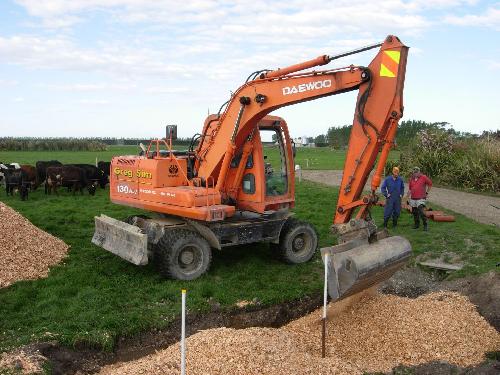URBANA, Ill. - Last summer, the Gulf of Mexico's "dead zone" spanned more than 6,400 square miles, more than three times the size it should have been, according to the Gulf Hypoxia Task Force. Nitrogen runoff from farms along the Mississippi River winds up in the Gulf, feeding algae but depriving other marine life of oxygen when the algae decomposes. The 12 states that border the Mississippi have been mandated to develop nutrient reduction strategies, but one especially effective strategy has not been adopted widely: bioreactors.
Bioreactors are passive filtration systems that capitalize on a bacterial process known as denitrification to remove from 25 to 45 percent of the nitrate in water draining from farm fields. Research on and installation of bioreactors has accelerated in the past decade, but University of Illinois assistant professor of water quality Laura Christianson and her colleagues are urging a move past proof-of-concept toward large-scale deployment.
"Bioreactors are one of the most effective edge-of-field practices, but until now, they haven't been rolled out on a large scale," Christianson says.

Designs vary, but the typical arrangement for a 40- to 80-acre field is a large (100 x 20 foot) pit situated just ahead of where drainage pipes flow into ditches or streams. The pit is filled with carbon-rich organic material: usually wood chips, but sometimes corn cobs, biochar, or other matter. Denitrifying bacteria make their homes in the organic material and utilize its carbon as an energy source to convert nitrate in the water to the harmless nitrogen gas that makes up 78 percent of our atmosphere.
A benefit of bioreactors as a nitrogen management strategy is their cost-benefit ratio. Bioreactors can cost approximately $10,000 to install, but cost-sharing is available through the USDA's Natural Resources Conservation Service for approximately half of that. Importantly, bioreactors typically operate for 10 years before wood chips need to be replaced.
"It's a big up-front cost compared to a cover crop, but then you're 'one and done' for 10 years," Christianson notes.
Christianson put together a special issue of the Journal of Environmental Quality focusing on bioreactors. Fifteen articles in the issue summarize the state-of-the-art of bioreactor technology, confirming that bioreactors could be an effective part of an integrated approach to nitrate management.
A large component to bioreactor efficiency is design.
According to Christianson and other experts contributing to the special issue, flow rates can significantly affect the efficiency of bioreactors. During low-flow periods, water can be held in bioreactors for too long, setting up conditions for different bacteria that create noxious hydrogen sulfide gas. Likewise, in high-flow periods, water may move through too quickly for efficient nitrogen removal.
"Tile drainage systems never flow at a consistent rate," Christianson explains. "Bioreactors have to be designed strategically to optimize retention time and maximize nitrate removal without undesirable byproducts."
Temperature and seasonal changes also affect how well bioreactors work.
"The critical period for nitrate loss is early spring, before plants are growing and taking up nitrogen," Christianson says. "Snowmelt puts a significant amount of water through a bioreactor, depending on where you are. And because snowmelt and early spring drainage water is cooler, the bacteria aren't as efficient."
Christianson and her colleagues are calling for more field-scale research to optimize design for the set of conditions unique to each field.
"That's where my interest is for research: coming up with better designs. But on the other side of that coin, we don't want to become so advanced in the design that it becomes really complicated. There's a beauty in the simplicity of a trench full of woodchips," Christianson says.
The article introducing the special issue, "Moving denitrifying bioreactors beyond proof of concept: Introduction to the special section," appears in the Journal of Environmental Quality along with 14 additional articles on the topic. Christianson co-authored the introductory article with Louis Schipper of the University of Waikato in New Zealand.




Comments